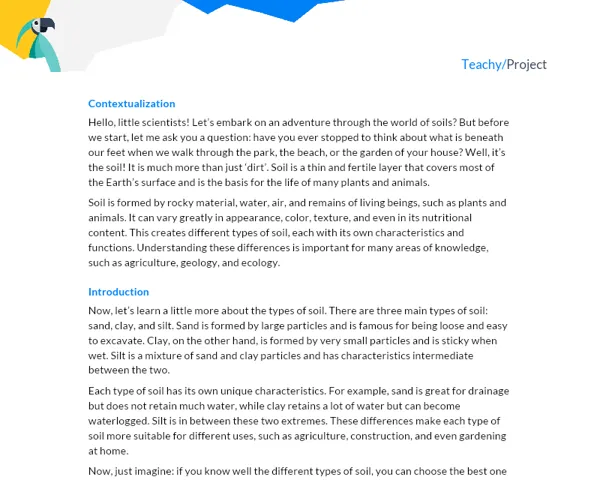Contextualization
Mixtures are part of our daily lives, whether in our bodies, in the atmosphere, or in the foods and beverages we consume. From our breakfast to dinner, we encounter various mixtures and separation processes. They are also essential in industry, whether in the manufacturing of medicines, foods, or chemicals.
Understanding the phases of a mixture is essential, not only for science but also for various fields such as engineering, medicine, culinary, and even arts. Understanding how different substances interact with each other, forming different phases, can allow us to create new materials, medicines, and technologies.
In this project, we will explore the phases of mixtures, a fundamental concept in physics and chemistry. Mixtures can be homogeneous, where substances are uniformly distributed and we cannot distinguish their different parts, such as saltwater, or heterogeneous, where substances are distributed unevenly and we can distinguish their different parts, such as sand in water.
The differentiation between these mixtures is based on the observation of the existing phases. A phase is a homogeneous part of a mixture that we can identify visually or through physical properties. Considering the number of phases in a mixture can help us better understand the nature of the mixture and how to separate it efficiently.
Furthermore, this knowledge will play an important role in understanding more advanced concepts in chemistry, such as chemical reactions and states of matter, and in physics, such as thermodynamics and fluid mechanics.
During the development of this project, you can refer to the book 'Chemistry: The Central Science' by Theodore L. Brown, which is available in the school library; the YouTube channel 'Chemistry in Action,' which features explanatory videos on various chemistry concepts; and the website 'Brazil School,' which presents articles, exercises, and summaries on the subject.
Practical Activity
Title: Exploring the Phases of Mixtures: A Practical and Theoretical Approach
General Project Objective:
Recognize and analyze the phases of mixtures in different materials and produce a detailed report describing the observations and results obtained.
Specific Objectives:
- Understand the concept of homogeneous and heterogeneous mixtures.
- Observe and count the number of phases in different types of mixtures.
- Exercise teamwork, time management, communication, and problem-solving skills.
- Deepen knowledge of laboratory procedures, equipment, and safety.
Detailed Project Description:
In these experiments, the groups will investigate different types of mixtures. In each of the mixtures, they should identify whether they are homogeneous or heterogeneous, based on the existence of distinct phases. Each group (composed of 3 to 5 students) will be responsible for data collection, analysis of results, and production of a detailed report.
Required Materials:
The materials needed for this practical activity are:
- Beakers and test tubes
- Microscopes
- Different types of materials for mixtures, such as water, oil, sand, salt, vinegar, ink, milk, etc.
- Spatulas
- Stopwatch
- Paper, pencil, and eraser
- Cameras or cell phones with cameras (to document the experiments)
Detailed Step-by-Step for Activity Execution:
1. Planning: Students should gather and plan which mixtures they will investigate and how they will proceed. This time can be used to research theoretical fundamentals, discuss the necessary materials and their safety in use, as well as to separate and organize the materials for the experiments.
2. Execution: Based on the planning, each group should prepare and conduct the experiments. During this stage, it is important that all group members participate in the tasks, documenting and discussing their results. This process should be repeated with all mixtures chosen for study.
3. Analysis: After conducting the experiments, students will review the collected data, looking for patterns and relationships. They should organize the data into tables and graphs and discuss their findings.
4. Report Writing: Finally, students will be responsible for writing a detailed report. This report should include a summary of the procedure, a detailed description of the experiments and the collected results. In addition, students should include a discussion of their findings, including the identification of phases, observed mixtures, differences between homogeneous and heterogeneous mixtures, and how the results relate to the theory they learned in the classroom.
Project Deliverables:
-
Laboratory Report: The report should be written according to scientific standards, containing: Introduction (contextualization of the theme, relevance and real-world application, and project objective), Development (explanation of theory, detailed activity, methodology used, presentation and discussion of results), Conclusions (summary of key points, learnings, and conclusions about the project), and Bibliography (sources used in the project).
-
Oral Presentation: At the end of the project, each group must prepare and deliver an oral presentation on their findings. The presentation should include a description of the experiments, results, and conclusions. In addition, they should be prepared to answer questions and discussions generated by their peers and teachers.
Note: The development of this project should require more than twelve hours per student, given its complexity and scope. Therefore, it is essential that students practice efficient time management to ensure that all project steps are completed on time.

